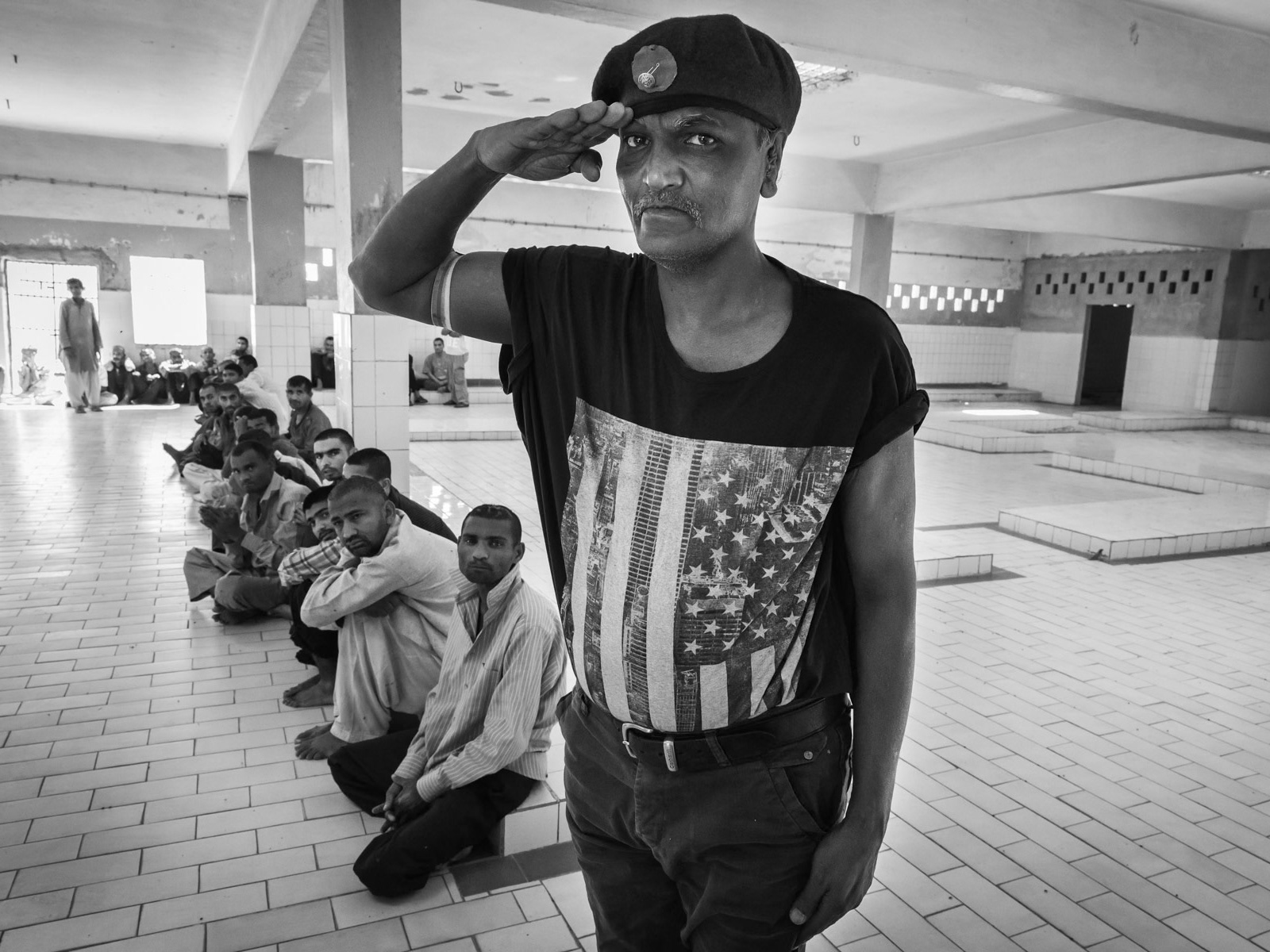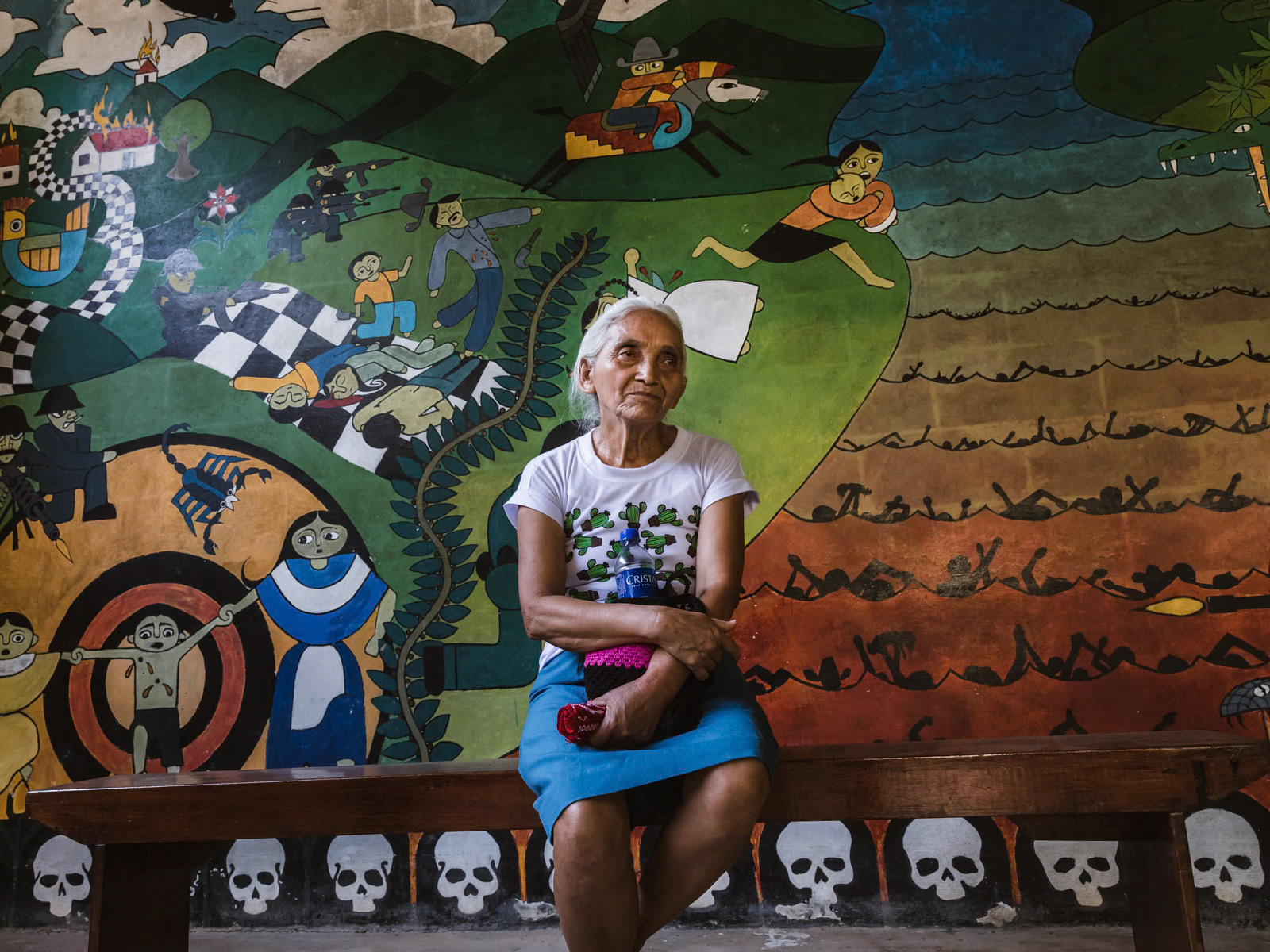The Western Sahara, a former Spanish colony in Northwestern Africa, remains one of Africa’s most enduring frozen conflicts. For over forty years, the Sahrawi people have lived in a state of limbo, with the territory divided between Morocco and the Polisario Front, a Sahrawi nationalist independence movement. A heavily mined 1,600-kilometer sand wall, or berm, splits the region in two, with Morocco controlling the resource-rich coastal areas to the west and the Polisario holding a small strip of desert bordering Algeria.
Morocco has effectively integrated its portion of Western Sahara, termed the "Southern Provinces," into its national framework. Over decades, it has encouraged Moroccan settlement in the region to strengthen its claims while exploiting its abundant phosphate reserves and fish stocks. This consolidation has fueled resentment among the Sahrawi people, represented politically by the Sahrawi Arab Democratic Republic (SADR).
Tensions reignited on November 14, 2020, when SADR President Brahim Ghali ended a 29-year-old ceasefire. The decision followed a Moroccan military intervention at a blocked border crossing in the UN-monitored buffer zone, which the SADR interpreted as an act of war. Since then, the Polisario Front has launched attacks against Moroccan forces stationed along the sand berm, adopting guerilla tactics to offset their numerical disadvantage.
Morocco, meanwhile, has fortified its positions and increasingly relied on advanced technologies, including attack drones, to counter the Polisario’s mobile units. These drones have added a new dimension to the conflict, challenging the Polisario's operational mobility across the vast desert battlefield. Despite these escalations, the international community remains divided over the issue, with little progress toward a lasting resolution, leaving the Sahrawi people's aspirations for self-determination unfulfilled.
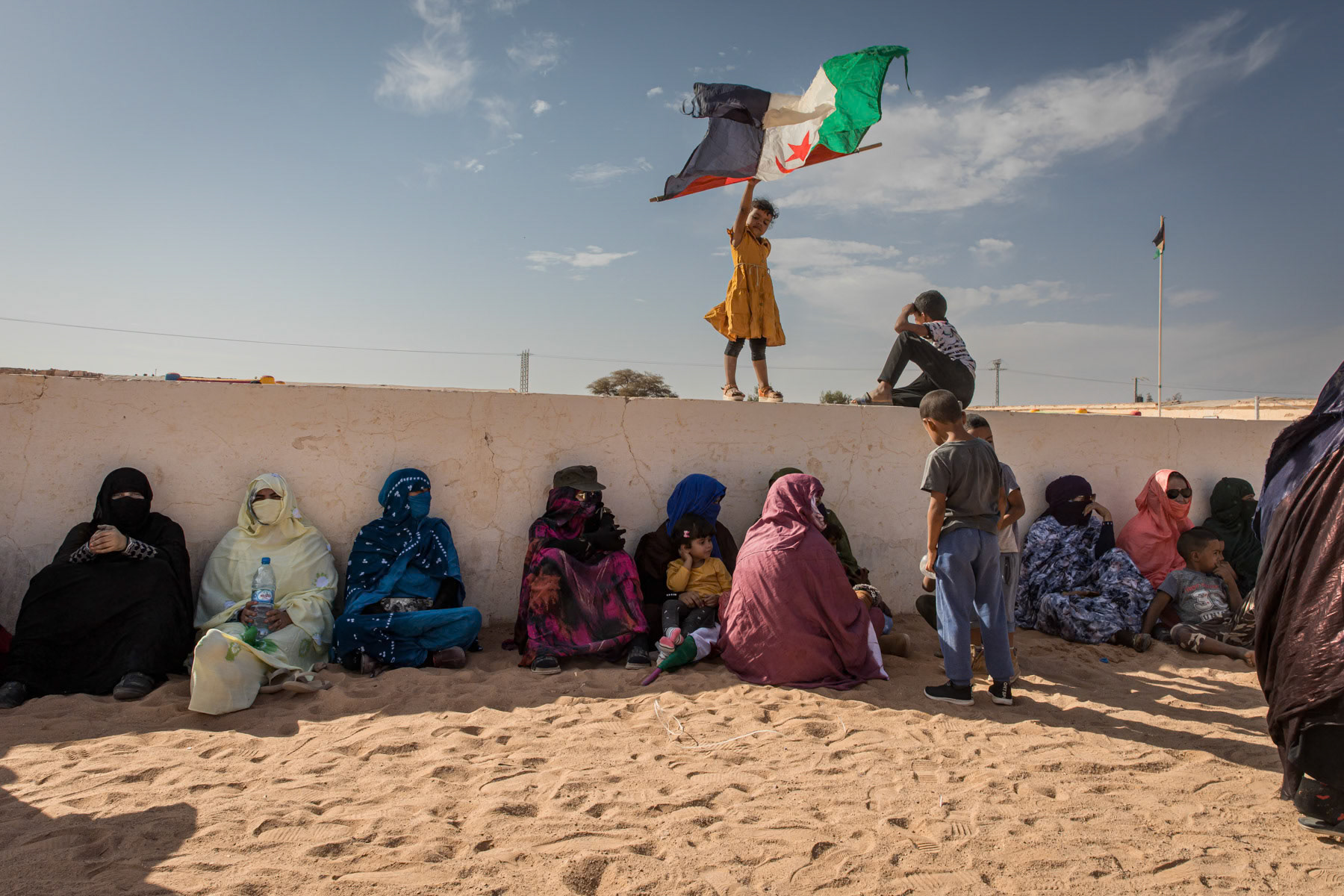
Saharawi girl waving the Saharawi National flag at a rehearsel for a ceremony for the 'Day of Unity' to take place the following day. Boujdor refugee camp in southern Algeria, October 2021

Sahrawi mobile military units of the Polisario Front moving towards the confrontation line. Since October 2020 the 20 year cease-fire has been abandonned by the Polisario Front and hostilities and fire exchange have resumed between Morocco and the Polisario Front. Second military region of the Sahrawi Arab Democratic Republic, October 2021

Sahrawi soldiers moving up a berm on the frontline to monitor the rocket impact they are about to launch towards Maroccan positions merely 5 km away and the 2,700 km long sand wall protection, built by Morocco, dividing the Western Sahara between the Moroccan controlled territories and Sahrawi liberated territories. Undisclosed location behind the frontline in the liberated Sahrawi territories, Sahrawi Arab Democratic Republic, October 2021

On 14 November 2020, the Sahrawi Arab Democratic Republic (SADR) president Brahim Ghali announced that he signed a decree bringing the 29 year old ceasefire to an end, citing an incident 2 days earlier in which Moroccan armed forces forcibly entered a crossing within the buffer zone that was being blocked by Sahrawi protesters, acts which the SADR considered a declaration of war. Since then the Polisario Front, the armed branch of the SADR, has been launching attacks against Moroccan positions along the 2,700 km sand wall that divides the territories controlled by Morocco since the 1991 ceasefire and the remaining 20% of the territory controlled by the SADR. Being outnumbered the Polisario Front uses highly mobile units to attack and adopts guerilla techniques while Morocco has numerous troops engraved in bunkers along the sand berm forming the frontline. The Moroccan army has also started tu use attack drones further complicating the Polisario's mobility capacity in this huge desert battlefield. Sahrawi soldier in a military active zone of the 2nd military region of the liberated territories of the Sahrawi Arab Democratic Republic (SADR). Frontline area near Mahbez, Western Sahara, October 2021

Sahrawi woman with the national flag assisting to festivities at the occasion of the 'National Unity Day of the Sahrawi People'. Boujdor Refugee Camp, Algeria, October 2021

Sahrawi soldier in a military active zone of the 2nd military region of the liberated territories of the Sahrawi Arab Democratic Republic (SADR). Frontline area near Mahbez, Western Sahara, October 2021

Sahrawi soldiers and a modified mounted 'Grad' rocket launcher preparing to move towards frontline positions near 2,700 km long sand wall, built by Morocco, dividing the Western Sahara between the Moroccan controlled territories and Sahrawi liberated territories. Undisclosed location behind the frontline in the liberated Sahrawi territories, Sahrawi Arab Democratic Republic, October 2021

Sahrawi military drivers out of their vehicles in case of drone attacks waiting to transport back military staff from a frontline position. Undisclosed location in the liberated territories of the Western Sahara, October 2021

Sahrawi military commander of a mobile unit operating at the frontline where Morocco has built a 2,700 km long sand berm dividing the Western Sahara between the Moroccan controlled territories and Sahrawi liberated territories. Mobile camp in the desert in the northern second military region, Sahrawi Arab Democratic Republic, October 2021

Sahrawi military going on early morning reconnaissance in an undisclosed location near the frontline in the second militarty region of the Sahrawi Arab Democratic Republic (SADR). Vehicles have their roof cut out and body parts are smeared with mud and sand in order to be less reflective against drone attacks. Undisclosed location in the liberated territories of the Western Sahara, October 2021

Sahrawi military officer driven to base camp inside the Sahrawi liberated territories of the Western Sahara, October 2021

Children rehearsing for the ceremony of the Sahrawi 'Day of Unity', a national day on 12 October. Boujdor Saharawi refugee camp in the Sahara desert, Algeria, October 2021

Sahrawi mobile military finding the little shade available in this hostile environment. Since October 2020 the 20 year cease-fire has been abandonned by the Polisario Front and hostilities and fire exchange have resumed between Morocco and the Polisario Front. Second military region of the Sahrawi Arab Democratic Republic, October 2021

Sahrawi military transport at the frontline with drivers out of their vehicles in case of drone attacks. For the same reasons vehicles have their roof cut out and body parts smeared with mud and sand in order to be less reflective against drone. Undisclosed location in the liberated territories of the Western Sahara, October 2021

A Sahrawi soldier and a slaughtered goat in the liberated territories of the Sahrawi Arab Democratic Republic (SADR). Frontline area near Mahbez, Western Sahara, October 2021

Sahrawi girl playing around her house. Saharawi refugee camps were established in the seventies in an area managed by the POLISARIO, the government in exile of the Saharawi Arab Democratic Republic (SADR). Between 120 and 150,000 refugees from the Western Sahara live in 5 refugee camps in the desert south of Tindouf. Boujdor Refugee Camp, Algeria, October 2021
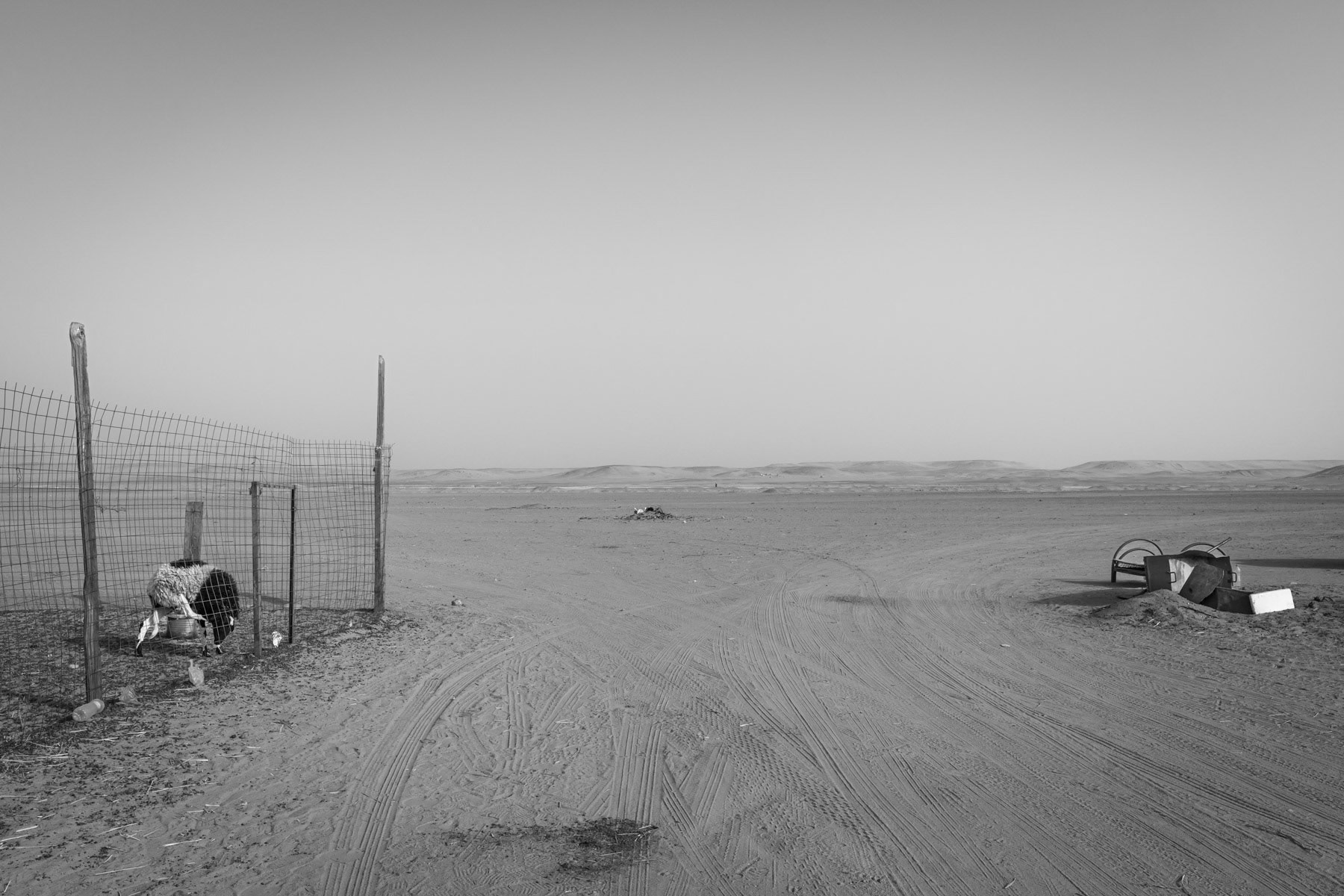
Livestock market of Boujdor Refugee Camp. Due to Covid-19 restriction and the resumption of armed conflict in the Western Sahara, available livestock and commercial exchanges with Mauritania have been severely reduced. Boujdor Refugee Camp, Algeria, October 2021

Sahrawi woman leading children and rehearsing for the ceremony of the Sahrawi 'Day of Unity', a national day on 12 October. Boujdor Saharawi refugee camp in the Sahara desert, Algeria, October 2021

Sahrawi soldier near the frontline and the 2,700 km long sand berm, built by Morocco, dividing the Western Sahara between the Moroccan controlled territories and Sahrawi liberated territories. Undisclosed location behind the frontline in the liberated Sahrawi territories, Sahrawi Arab Democratic Republic, October 2021

Sahrawi military leaving to join other units in an undisclosed location near the frontline in the second militarty region of the Sahrawi Arab Democratic Republic (SADR). Vehicles have their roof cut out and body parts are smeared with mud and sand in order to be less reflective against drone attacks. Undisclosed location in the liberated territories of the Western Sahara, October 2021

Sahrawi soldiers breaking up their mobile camp in a military active zone of the 2nd military region of the liberated territories of the Sahrawi Arab Democratic Republic (SADR). Frontline area near Mahbez, Western Sahara, October 2021

Sahrawi soldiers preparing tea before moving. Organised as a guerilla, Sahrawi military change their camp location on quasi daily basis and are extremely mobile. Liberated territories of the Sahrawi Arab Democratic Republic, October 2021

Members of a Sahrawi military unit having lunch at their base camp at an undisclosed location in the Western Sahara desert. Sahrawi Arab Democratic Republic, October 2021

On 14 November 2020, the Sahrawi Arab Democratic Republic (SADR) president Brahim Ghali announced that he signed a decree bringing the 29 year old ceasefire to an end, citing an incident 2 days earlier in which Moroccan armed forces forcibly entered a crossing within the buffer zone that was being blocked by Sahrawi protesters, acts which the SADR considered a declaration of war. Since then the Polisario Front, the armed branch of the SADR, has been launching attacks against Moroccan positions along the 2,700 km sand wall that divides the territories controlled by Morocco since the 1991 ceasefire and the remaining 20% of the territory controlled by the SADR. Being outnumbered the Polisario Front uses highly mobile units to attack and adopts guerilla techniques while Morocco has numerous troops engraved in bunkers along the sand berm forming the frontline. The Moroccan army has also started tu use attack drones further complicating the Polisario's mobility capacity in this huge desert battlefield. Sahrawi military commander communicating with his untis on the frontline near the 2,700 km long sand berm, built by Morocco, dividing the Western Sahara between the Moroccan controlled territories and Sahrawi liberated territories. Mobile camp in the desert in the northern second military region, Sahrawi Arab Democratic Republic, October 2021

Sahrawi military leaving to join other units in an undisclosed location near the frontline in the second militarty region of the Sahrawi Arab Democratic Republic (SADR). Vehicles have their roof cut out and body parts are smeared with mud and sand in order to be less reflective against drone attacks. Undisclosed location in the liberated territories of the Western Sahara, October 2021

Children playing in one of the Sahrawi Refugee Camps. Saharawi refugee camps were established in the seventies in an area managed by the POLISARIO, the government in exile of the Saharawi Arab Democratic Republic (SADR). Between 120 and 150,000 refugees from the Western Sahara live in 5 refugee camps in the desert south of Tindouf. Boujdor Refugee Camp, Algeria, October 2021

Sahrawi woman catching mobile phone signal in Boujdor Refugee Camp, Algeria, October 2021
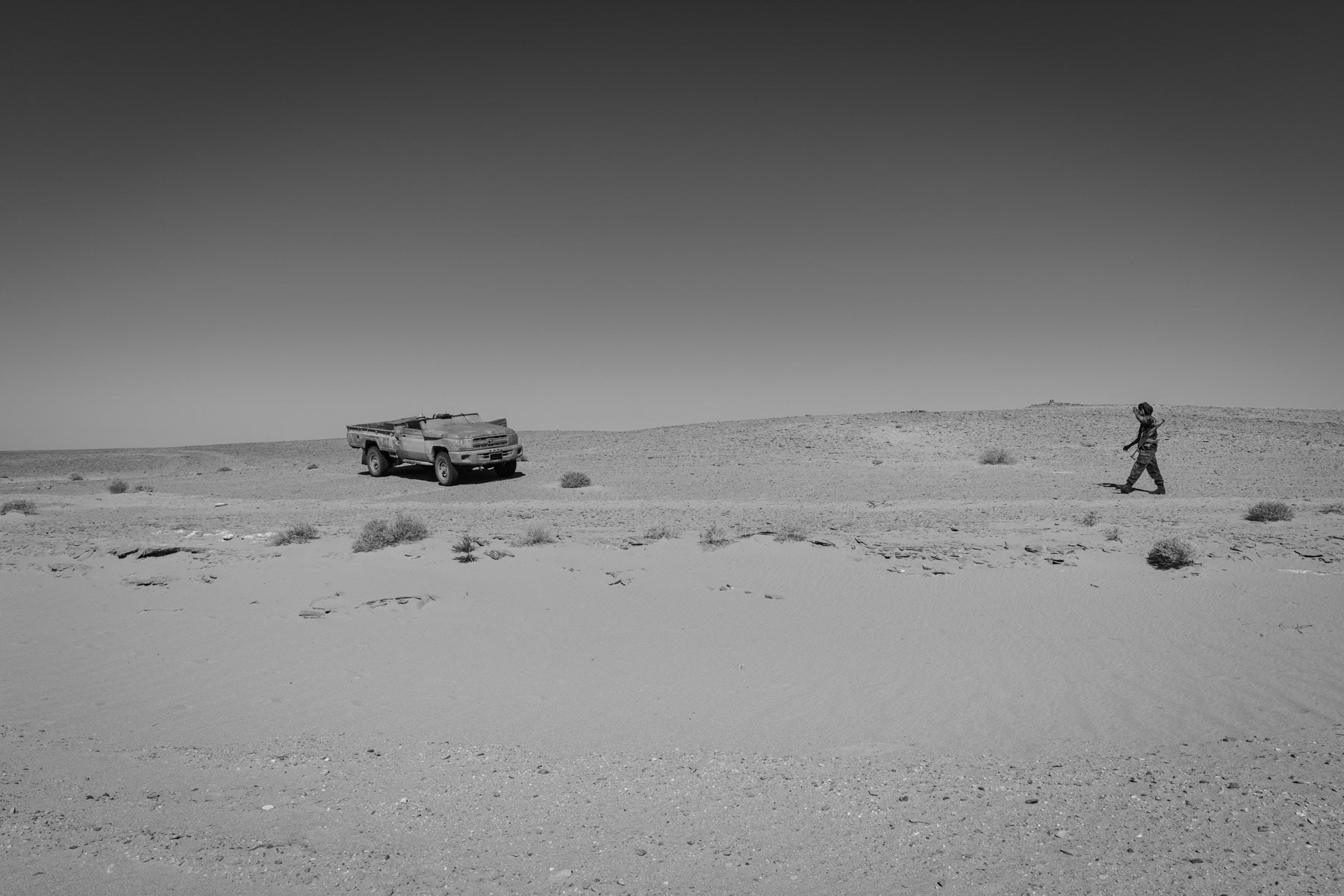
Sahrawi soldiers preparing to move towards frontline positions near 2,700 km long sand wall, built by Morocco, dividing the Western Sahara between the Moroccan controlled territories and Sahrawi liberated territories. Undisclosed location behind the frontline in the liberated Sahrawi territories, Sahrawi Arab Democratic Republic, October 2021

A water truck being re-filled at the Boujdor filling water station. For the past 45 years since the refugee camps were established water is only available through truck distribution and the filling of individual household tanks. Boujdor Refugee Camp, Algeria, October 2021

Sahrawi soldiers breaking up their mobile camp in a military active zone of the 2nd military region of the liberated territories of the Sahrawi Arab Democratic Republic (SADR). Frontline area near Mahbez, Western Sahara, October 2021

Sahrawi soldiers preparing to move towards frontline positions near 2,700 km long sand wall, built by Morocco, dividing the Western Sahara between the Moroccan controlled territories and Sahrawi liberated territories. Undisclosed location behind the frontline in the liberated Sahrawi territories, Sahrawi Arab Democratic Republic, October 2021

Endless stretches of desert in the contested territory of the Western Sahara. Mahbez sector of the second military region of the Sahrawi Arab Democratic Republic, October 2021

Members of a Sahrawi military unit having a rest at their base camp at an undisclosed location in the Western Sahara desert. Second military region, Sahrawi Arab Democratic Republic, October 2021

Saharawi military officer at an outlook point on the frontline. Second military region of the Sahrawi Arab Democratic Republic, October 2021

Sahrawi soldier taking position on a high point to overlook artilley strikes towards Maroccan positions 5 km away engraved behind a 2,700 km long sand berm, de facto dividing the Western Sahara from North to South and forming probably one of the longest active frontline in the world. Frontline, Western Sahara, October 2021

Nuha Abidan, member of the Association of the Families of Sahrawi Prisoners and Disappeared. Her father disappeared in 1976 at the begining of the conflict between Morocco and the Polisario Front. The Moroccan Authorities reported in 2010 that he had died of illness in prison in 1980, but without providing any proof thereof Sahrawi families still seek the full thruth about the exact circumstance of their death and the whereabouts of their remains. Boujdor Refugee Camp, Algeria, October 2021





